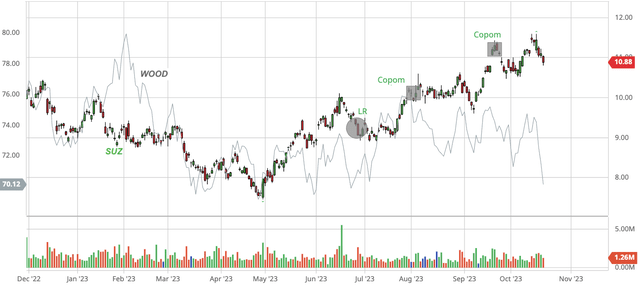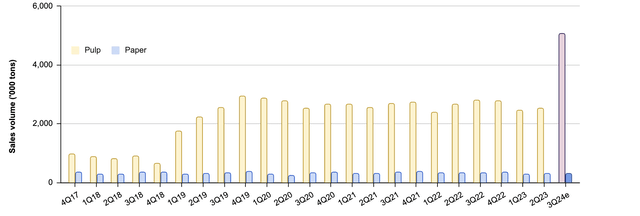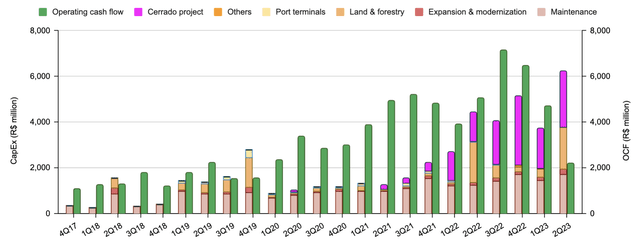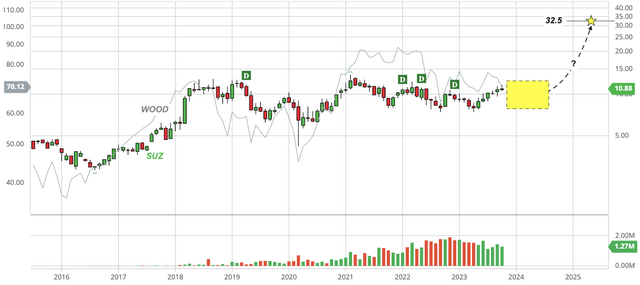Since my previous article on Suzano S.A. (NYSE:SUZ), the leader in the pulp and paper industry, the company has released its second-quarter 2023 results. Additionally, the Brazilian central bank cut its benchmark interest rate by half a percentage point on August 2 and repeated the action on September 20, indicating the start of a series of cuts. During the four months since that article, the Suzano stock gained 16.5%, as illustrated in Figure 1.
Fig. 1. Stock chart of Suzano as compared with iShares Global Timber & Forestry ETF (WOOD), shown with Brazilian central bank rate cuts (Copom) and Laurentian Research buy recommendation (LR) (modified from Barchart and Seeking Alpha)
Suzano is scheduled to release its third-quarter 2023 results on October 26, followed by the annual investor day on the next day. It’s time to assess how our investment thesis has fared so far and review the factors that have been driving the recent share price gains.
Operations
Since closing the deal to purchase its larger domestic rival, Fibria Celulose SA, in early 2019, Suzano has maintained pulp production and sales volume at approximately 2.6 million tons, and paper production volume around 310,000 tons, as shown in Figure 2. This consistency holds true despite fluctuations in pulp and paper prices.
Fig. 2. Quarterly sales volume of pulp and paper of Suzano (compiled by Laurentian Research for The Natural Resources Hub, based on financial data released by Suzano)
I anticipate that Suzano will maintain its pulp production at this level until the Cerrado project, located in Ribas do Rio Pardo, Mato Grosso do Sul, becomes operational by June 2024. The Cerrado project boasts an annual capacity of 2.55 million tons, effectively doubling Suzano’s pulp production from mid-2024 onward. By leveraging economies of scale and logistical gains, Suzano expects to reduce pulp cash costs to approximately R$500 per ton upon completing the learning curve at the Ribas do Rio Pardo plant. Furthermore, they aim to lower it to about R$400 per ton once the second forest cycle begins in 2031, excluding the impact of scheduled maintenance downtimes, as shown in Figure 3.
Fig. 3. Pulp cash cost of Suzano, actual and estimated (compiled by Laurentian Research for The Natural Resources Hub, based on financial data released by Suzano)
As for the Cerrado project, Aires Galhardo, Suzano executive officer for the pulp operation commented,
“In the Cerrado project, we reached 70% physical progress…, which allows us to have a more optimistic view for the schedule, [and] change our forecast for the start of production to June 2024. The financial schedule is also in line with the plan, reaching 57% of the expected disbursement with R$ 9.8 billion remaining to be carried out by 2024.”
Price
Unlike the generally rising paper prices, the price of pulp has been cyclical. Pulp prices entered another down-cycle at the beginning of 2023, dropping 31% in six months, as illustrated in Figure 4.
Fig. 4. Quarterly average prices of pulp and paper realized by Suzano (compiled by Laurentian Research for The Natural Resources Hub, based on financial data released by Suzano)
Financials
Primarily due to the weakness in pulp prices, Suzano saw its first significant decrease in revenue since acquiring Fibria Celulose SA in 2019. From the last quarter of 2022 to the second quarter of 2023, revenue declined by 36%, as shown in Figure 5. However, international sales still accounted for over 77% of the total revenue, as demonstrated in Figure 6.
Fig. 5. Net quarterly revenue of Suzano by the pulp and paper segments (compiled by Laurentian Research for The Natural Resources Hub, based on financial data released by Suzano) Fig. 6. Net quarterly revenue by source – foreign or domestic – of Suzano, shown with the percentage of foreign revenue contribution (compiled by Laurentian Research for The Natural Resources Hub, based on financial data released by Suzano)

Suzano maintained its production volume scale, as reflected in Figure 2, even as product prices plummeted (Figure 4). This had a negative impact on the adjusted EBITDA margin, which dropped from 57% in 4Q2022 to 43% in 2Q2023, as illustrated in Figure 7. Consequently, its adjusted EBITDA decreased by 52% during this period, as shown in Figure 8.
Fig. 7. Adjusted EBITDA margin by quarter of Suzano (compiled by Laurentian Research for The Natural Resources Hub, based on financial data released by Suzano) Fig. 8. Adjusted EBITDA by quarter of Suzano (compiled by Laurentian Research for The Natural Resources Hub, based on financial data released by Suzano)

Prior to accounting for dividend payments and maintenance capital expenditures, free cash flow has shown an upward trend, as seen in Figure 9. Further analysis of capital expenditures, depicted in Figure 10, reveals that operating cash flow sufficiently covered both maintenance and expansion-modernization costs, including significant investments in land, forestry, and the Cerrado project.
Fig. 9. Quarterly free cash flow, adjusted to pre-dividends and ex-maintenance CapEx (compiled by Laurentian Research for The Natural Resources Hub, based on financial data released by Suzano) Fig. 10. Quarterly capital expenditures of Suzano, as compared with operating cash flow (compiled by Laurentian Research for The Natural Resources Hub, based on financial data released by Suzano)

The acquisition of Fibria Celulose SA in the first quarter of 2019 led to Suzano’s net debt exceeding R$50 billion. Despite substantial investments in the Cerrado project, particularly since 2022, Suzano managed to reduce its net debt. Furthermore, the increase in adjusted EBITDA gradually lowered the net debt-to-adjusted EBITDA ratio to around 2.0X, as shown in Figure 11.
Fig. 11. Net debt by quarter and Net debt/Adjusted EBITDA ratio of Suzano (compiled by Laurentian Research for The Natural Resources Hub, based on financial data released by Suzano)
Looking ahead, I anticipate that the Cerrado project, expected to become operational by mid-2024, will substantially reduce capital expenditures and generate significant cash flow. This will enable Suzano to further reduce its leverage and potentially allocate more rewards to shareholders.
Upside and risks
As of October 19, 2023, Suzano was trading at a forward EV/EBITDA multiple of 7.25X. For comparison, industry peers UPM-Kymmene Oyj (OTCPK:UPMKF) were trading at 12.96X, International Paper (IP) at 7.76X, Stora Enso Oyj (OTC:SEOJF) at 12.13X, and Mondi plc (OTCPK:MONDF) at 7.26X. Suzano appears to be more attractively priced compared to its industry peers. From a historical perspective, Suzano’s EV/EBITDA multiple is also significantly lower than its trailing 10-year median EV/EBITDA multiple of 10.57X.
Assuming Suzano maintains its FCF growth pace with a CAGR of 10.7% over the next 10 years, a highly probable scenario given the progress at the Cerrado project, and posts no further growth thereafter, I estimate that, with a WACC of 7.0%, Suzano has an intrinsic value of $32.5 per share. This suggests a considerable margin of safety to compensate for potential risks as discussed below.
Among the risk factors enumerated in my previous article, the main uncertainty revolves around whether Suzano can complete the Cerrado project on schedule and on budget, which I believe it will. Another area of uncertainty lies in how competitors will respond when Suzano doubles its pulp production upon the start-up of Cerrado. Additionally, fluctuations in the exchange rates of the Brazilian Real against other currencies introduce uncertainties to Suzano’s financial performance.
Investor takeaways
As analyzed above, the recent strength in Suzano’s share price was likely primarily driven by the Brazilian central bank’s decision to reduce its benchmark interest rate. This came as the company reported a sharp decrease in revenue and profits due to the cyclical weakness in pulp prices.
Despite these cyclical changes in its financial performance, Suzano appears to have maintained its competitive advantage. In other words, the investment thesis for Suzano remains valid, especially considering that the stock is still attractively priced in comparison to its industry peers and historical median valuations.
Looking ahead, the Brazilian central bank is expected to continue reducing the Selic rate from its current level of 12.75% as of October 2023. This will create a favorable monetary policy environment for Brazilian equities, including Suzano.
Additionally, another significant catalyst is anticipated to come into play by June 2024, with the start of production at the Cerrado project. History has proven that periods of weakness in pulp prices offer excellent opportunities to buy Suzano stock (compare Figure 4 and Figure 12). Therefore, I maintain my buy rating on Suzano between now and mid-2024 for investors with a multi-year time horizon.
Fig. 12. Stock chart of Suzano, dividend back-adjusted, as compared with iShares Global Timber & Forestry ETF (WOOD), shown with estimated intrinsic value (modified from Barchart and Seeking Alpha)
Editor’s Note: This article discusses one or more securities that do not trade on a major U.S. exchange. Please be aware of the risks associated with these stocks.
Read the full article here



